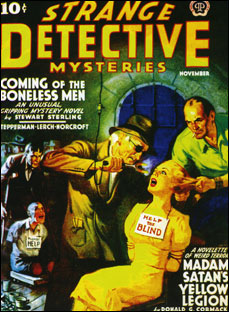Unburied treasureBrown's Pulp Uncovered festival March 7,
2007 2:15:25 PM

INFLUENTIAL: Pulp fiction is key to American culture.
|
Don’t throw out anything. If you want to understand your culture, America, don’t discard any contribution, even the trash fiction that’s at the opposite end of the literary spectrum from Good Books.
In that spirit the Pulp Uncovered festival taking place March 15-18 at Brown University was born. The roots of everything from adventure movies and film noir to today’s beach blanket reading owe much to the pulp magazines of the 1920s to 1940s. The festival wants to show us why we should care.
“Out of those you get pulp novels in the ’50s, comics in the ’30s,” says festival director Scott Tiffany, a filmmaker and Brown graduate student in public humanities. The event was his idea. “Focusing on the ’20s, ’30s, ’40s seems to make good sense. That’s really when it started, when it had the strongest impact on the culture.”
Tiffany traces popular working-class fiction back to the late 1700s in England, bringing it forward through the dime novel Westerns and penny dreadfuls of 19th-century America and into the post-World War I pulp publications of the 1920s, when science fiction magazines, for example, came out for the first time.
“Out of that the hard-boiled detective is born,” he says. “Film noir, which is so popular today, that noir look, is basically the gumshoe detective, a hard-boiled detective on the screen — they ripped those detectives out of the magazines.
“The idea of the superhero you see in the pulps before you see it in the comics,” he says. “The Shadow, the Spider, the Bat Man — before he was Batman — are figures that appear in pulp magazines before they appear in comics. Before Superman was the first huge comic guy — he was the Man of Steel — Doc Savage was the Man of Brawn. He was a pulp character.”
Joining in the discussion at the John Nicholas Brown Center is the director of the center, professor of American civilization Steven Lubar. “I guess I’m one of those people who could imagine rolling their eyes and saying, ’Why look at all this pulp?’ ” he says. “ ’There’s enough adventure in Moby-Dick, you don’t need to read pulp fiction.’ The answer is that it’s so important for understanding American culture. It shapes the way people think about the world.”
Lubar says that a fundamental contribution was made by all this bad writing. “It changed the lives of our imaginations,” he points out. “In most of them, there is this underworld of crooks and horror or this overworld of science fiction heroes and detectives and superheroes. I think it opens up the imagination in a fascinating way. There’s interesting scholarship on the way that people in the space program, they’re the ones who are reading those science fiction pulps, they’re the ones who are thinking, ’Yes, I will go to the moon someday when I grow up.’ So you can trace out the inspiration, especially on the science fiction side, that shows up when we go to the moon, that shows up in real life.”
|
 |

|
- In The Edge of Disaster, a security expert warns that the US is not prepared for future disasters
- Never mind its tough-girl alt-porn feminism: SuicideGirls has already moved on to a new generation
- Lesson One: the perils of sharing
- Oral is the new second base, the “mostly” girls keep on kissing girls, and the Bro Job has arrived (but is still not ready for its close-up)
- How one little post-war doughnut shop became synonymous with Boston’s identity
- Few on Deval Patrick's ‘fresh blood’ staff have been seasoned in the State-house hallways
- How one little post-war doughnut shop became synonymous with Boston’s identity
- Who’s looking at you, kid?
- SexyFront
- Last year’s New Times–Village Voice media merger pitted two kinds of journalism against each other. Guess who won?
- The abiding lessons of civil-rights-movement-era journalism
- Veteran New York editor Lance Gould to helm the weekly
|
-
Detritus and Crenca's energetic collaboration
-
Trinity Rep's splendid A Delicate Balance
-
Housing crunch
-
The Rhode Island Writers’ Circle Anthology
-
Perishable’s probing Constitutional
-
Viva las ropas viejas
-
2nd Story’s madcap Flea In Her Ear
-
Providence Black Rep’s Black Maria
-
Brews, ballgames, and much more
|
- A study of two states at the Newport Art Museum
- Striking images of Narragansett Bay at Save the Bay
- Cristin Searles’s playful “Installation”
- Amy Cutler’s fantastical world
- Cecily Brown’s paintings at the MFA, Louise Bourgeois’s dolls in Worcester
- Surveillance and power at the Rose
- Nan Goldin and Anna Palakunnathu Matthew
- Haute couture storms the MFA
- Digging the media in ‘Sensorium’
- Jennifer Bartlett’s breakthrough masterpiece and photographers of the future
|
|